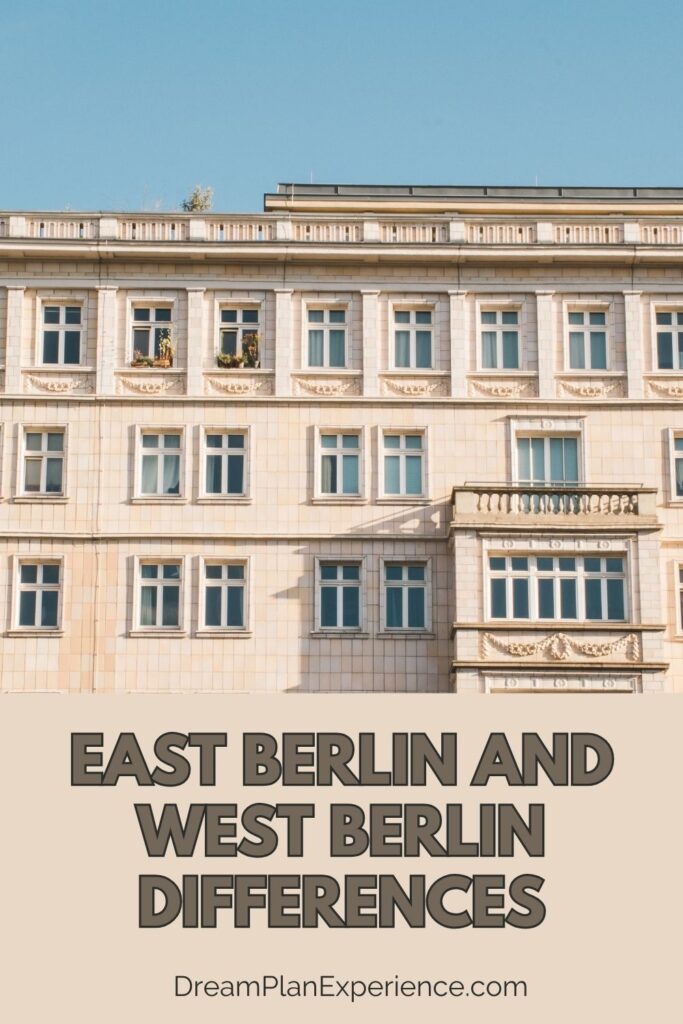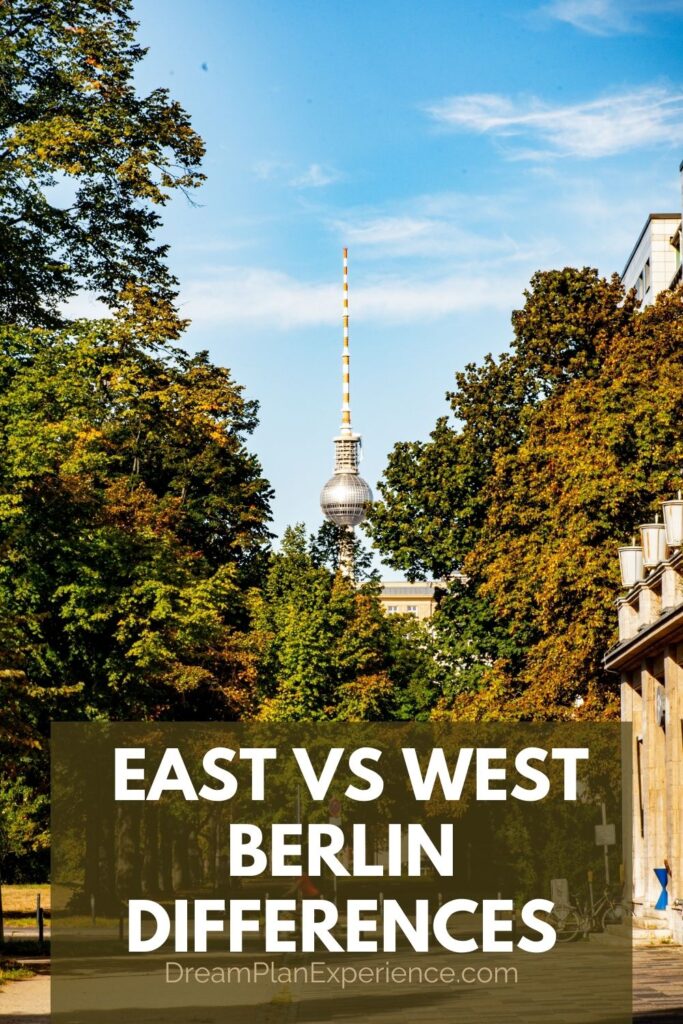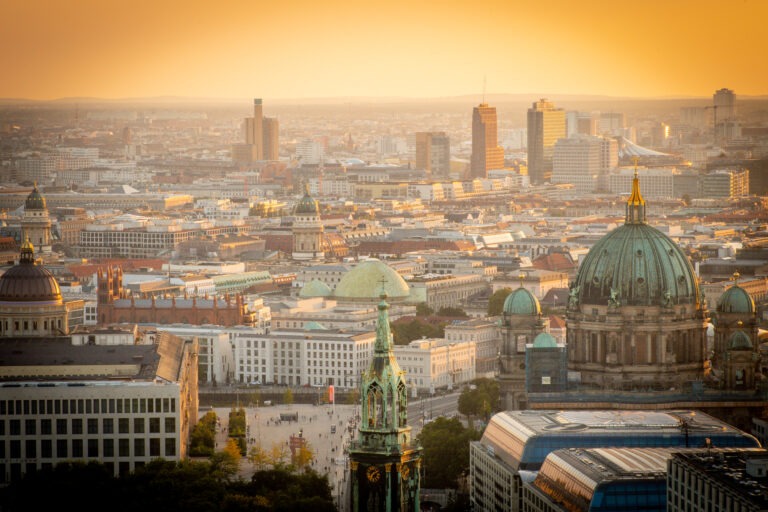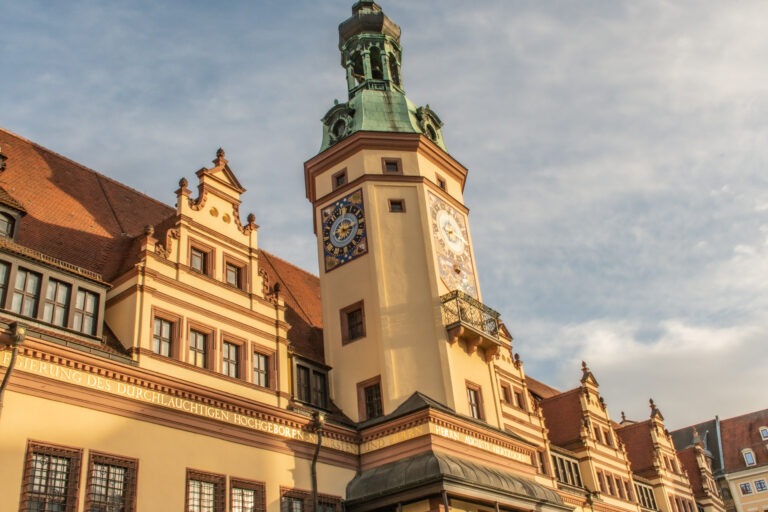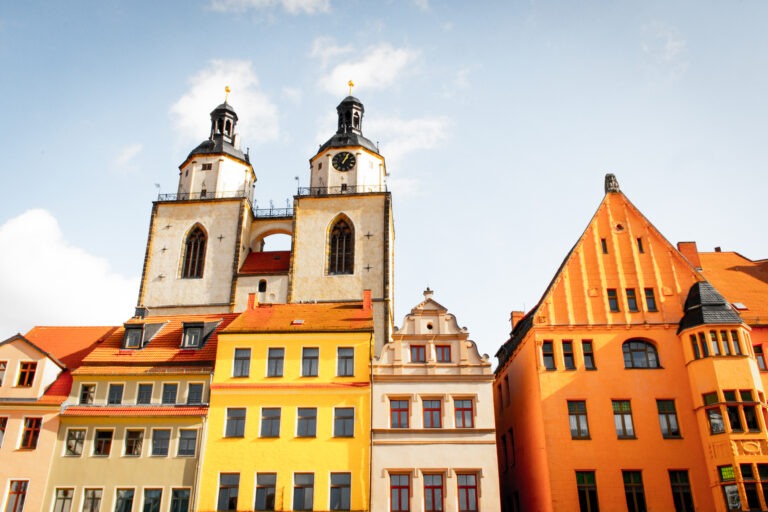Top 11 East Berlin and West Berlin Differences
East Berlin vs West Berlin is a fascinating history and is full of contrasts.
Are you interested in knowing more about the East Berlin and West Berlin differences as I am?
Once divided by a physical barrier and ideological differences, these two halves of Germany’s capital city have since become unified, yet remnants of their unique past still linger.
As a student studying in West Germany in 1988, a year before the fall of the Berlin Wall, I spent a week in West Berlin which included a border crossing at Checkpoint Charlie to East Berlin for the day. Bearing witness to the cultural differences between East and West Germany is one of the reasons that drove me to study Political Science at University once I returned home to Canada.
Fast forward to today, I’ve returned to Berlin and am living in the former East Berlin. I set out to discover the East-West Berlin differences. Intrigued to find out what they are?
Let’s uncover the differences between East vs West Berlin.
Whether you’re planning a visit or simply seeking to broaden your knowledge, this article will provide a helpful overview of the distinct characteristics that highlight the difference between East and West Berlin.
Table of Contents
This post may contain affiliate links. If you click on an affiliate link, at no additional cost to you, I will earn a small commission if you decide to book. Please check out my privacy policy and disclosure for more information.
The Past: East vs West Germany
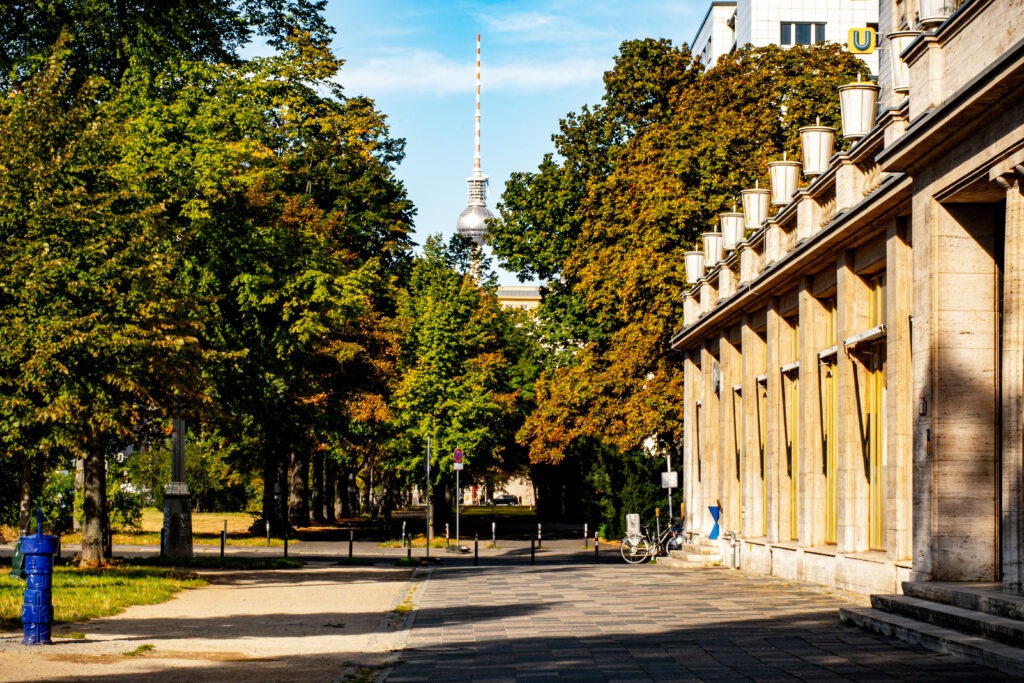
The stark East and West Germany differences emerged after World War II. After the war, the city of Berlin was divided into four zones of occupation, with the Soviet Union controlling the eastern part and the United States, Great Britain, and France overseeing the western part of the city. The most famous border crossing was at Checkpoint Charlie.
This initial division laid the foundation for the ideological and political divide that would define East Germany and West Germany for decades to come.
Life in East Germany, under Soviet influence, a socialist regime was established, characterized by a centrally planned economy and restricted personal freedoms. Meanwhile, West Germany embraced capitalism, democracy, and closer ties to Western nations.
These distinct paths led to vastly different living conditions, economic opportunities, and political systems on either side of the Berlin Wall, shaping the destinies of millions of people living in these contrasting lifestyles.
Timeline of Key Dates in History
- 1949: Germany formally split into two independent nations. The Federal Republic of Germany (FDR or West Germany), was allied with the Western democracies, and the German Democratic Republic (GDR or East Germany/DDR in German), was allied to the Soviet Union.
- 1952: The East German government closed the border with West Germany, but the border between Berlin West and East remained open.
- 1961: Overnight on August 12-13 a barbed wire barricade encircled West Berlin from Eastern Berlin dividing neighbourhoods and families in Berlin.
- 1961 to 1989: Both East and West Berlin underwent massive urban development and city planning separately.
- 1989: On November 9 the Berlin Wall fell and it was the first step in German unification between West Germany and East Germany.
- 1990: On October 3, Germany officially reunited, 11 months after the fall of the Berlin Wall.
The Present: East vs West Berlin
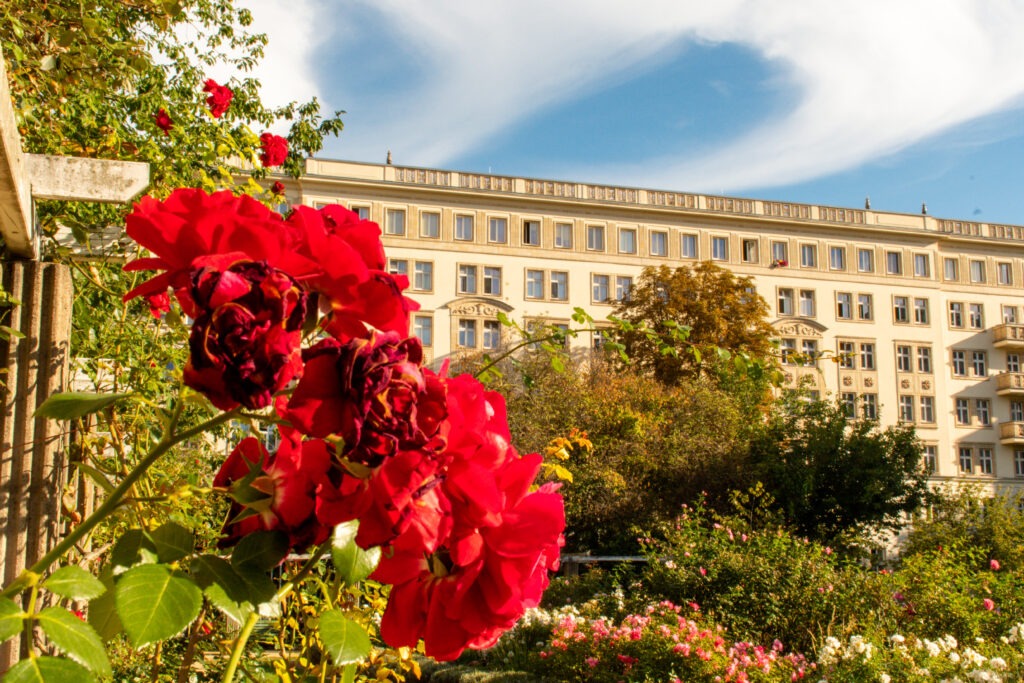
Fast-forward to today and the differences between Berlin East-West have evolved, while their historical roots still leave a mark on the city’s character.
Many architectural distinctions have blurred as the city underwent extensive renovations and redevelopment after reunification. While remnants of the Wall and East Berlin’s socialist architecture can still be found, modern construction and revitalization efforts have given rise to a more unified urban landscape.
The economic gap that once separated the two sides has also considerably narrowed, with East Berlin experiencing a resurgence as a creative and cultural hub. However, certain subtle contrasts remain, with East Berlin often embracing its gritty and artistic identity, while West Berlin maintains its reputation as a commercial and cosmopolitan center.
Remnants of West and East Germany
Berlin today is an outdoor museum. History plaques all over the city offer a poignant journey through the tumultuous history of the Berlin Wall. That’s what makes Berlin worth visiting.
Beyond the popular East Side Gallery or even Gedenkstätte Berliner Mauer, stroll along the city’s streets, and you’ll encounter informative plaques showing historical photos along with events or stories of what East Berlin life was like in that specific area.
Become an expert on Berlin during the Third Reich and the Cold War on this Walking Tour. Check availability and prices.
Each of these windows into the past serves as a simple yet powerful marker to recount the stories of division, escape attempts and the human resilience that defined the era. Standing at the very locations where historical events unfolded, these plaques bridge the gap between past and present.
🌠Insider’s tip: start at Schwedter Str (nearby Mauerpark, where you will find the popular Sunday flea market) and walk along the memorial trail to the Berlin Wall Memorial at Ackerstrasse (or do it in reverse).
11 East Berlin and West Berlin Differences

1. Ethnicity
East and West Berlin also differed in terms of ethnic diversity due to migration restrictions.
During the 1960s and 1970s, Western Germany initiated a program to bring in migrant workers, mainly from Turkey and Arab countries, to address workforce shortages in men. These new immigrants lived in the neighbourhoods of Wedding, Kreuzberg, and Neukölln. While East Berlin had a more homogenous population ethnically.
That’s why you can get some of the best Turkish cuisine in Berlin, and specifically in these neighbourhoods. The legend says that the doner kebab was invented in Berlin by a Turkish immigrant.
🌠Insider’s tip: Head to the district of Moabit for the endless choices of Donair, Falfel and even Turkish bakeries (Turmstrasse).
2. Panel Buildings (Plattenbauten)

Panel buildings stood as distinct markers of the architectural divergence between East and West Berlin. In East Berlin, these utilitarian structures, known as Plattenbauten, dominated the landscape, embodying the socialist principles of efficiency and uniformity.
In contrast, West Berlin focused on a wider range of architectural styles, reflecting historical influences and a more diverse approach to design.
If you want to get a glimpse into what life was like for East Berliners, you’ll want to visit the DDR Museum. Apartments are reconstructed and this is your chance to sit in a Trabi. Another, free museum that also gives you a great glimpse into the life of an East Berliner can be found in the Kulturbrauerei Museum.
3. Address Numbering Systems
You might wonder why some streets change names at intersections, even though they’re essentially the same road.
In the East, a street starts at 1, the next gets 2, and so on. At the street’s end, it jumps to the opposite side, continuing back with a new count. Imagine that a house on the left is 1, while the opposite one is 211.
🌠Insider’s tip: If you want to see an example of this walk along Metzer Strasse that turns into Schwedter Strasse.
It’s confusing and can lead to problems when the city expands. If a street grows longer, the numbers might not work, so a new name is given. If can’t find an address, and the logic of street numbers isn’t adding up, then you know you’re likely in the East.
4. Ampelmann
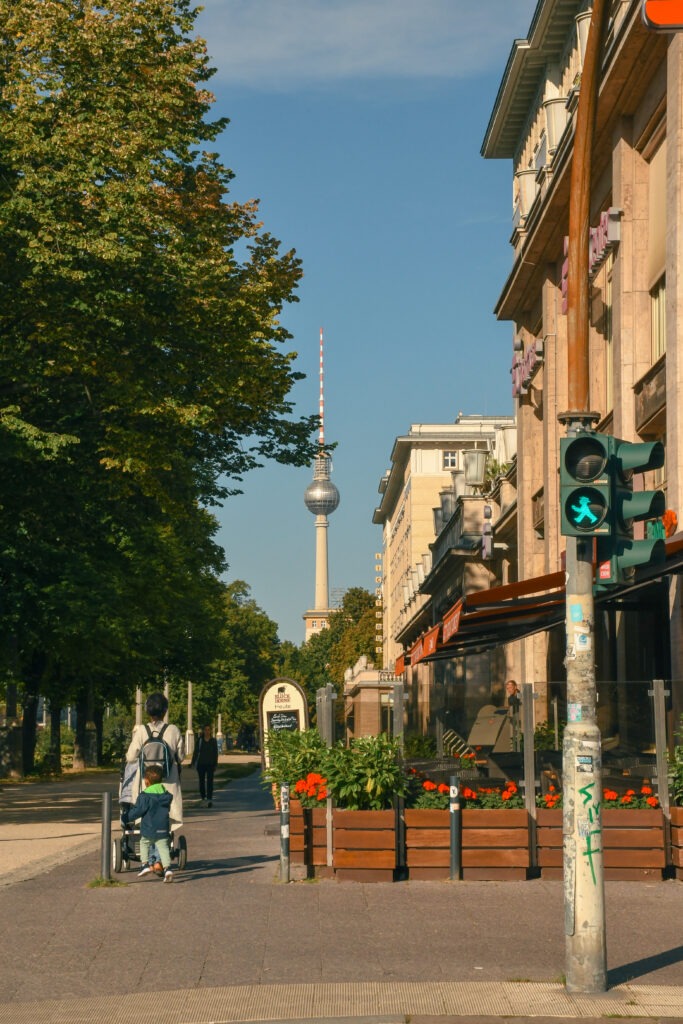

The Ampelmann, a charming pedestrian signal figure, became a symbol of East Berlin. It highlighted the city’s unique identity in pedestrian safety, embodying the socialist regime’s emphasis on functional design even in mundane aspects of urban life.
The Ampelmann remains a nostalgic icon, reflecting the quirkiness of East Berlin’s past. Upon reunification, the former West Berlin was adopted and that’s why you now see it all over the city. It’s what makes Berlin unique from any other city in the world.
🌠Insider’s tip: Berliners do not j-walk. They wait for the second the walk signal changes to green before crossing the street. If you see anyone crossing the street on a red (even if safe to do so) you’re bound to stick out as a tourist.
5. Yellow Trams
Berlin’s public transport is a maze of buses, subways, trains, and trams, all strictly separated between East and West. When the city reunited, West Berlin lost its entire streetcar system.
Today, if you’re into spotting trams, you might still find a few rolling in former East Berlin. Some lines have made a tentative comeback into the West over the past decades, but trams mostly belong to the daily life of the eastern side of the city.
6. Trabant or “Trabi”
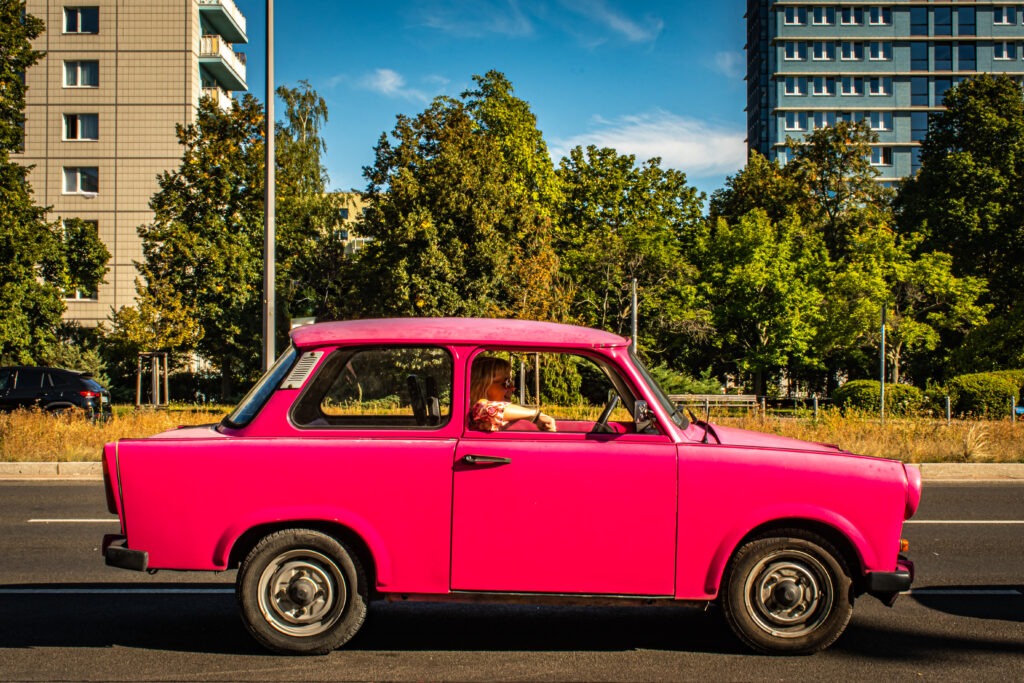
In East Germany, the iconic Trabant, or “Trabi,” emerged as a symbol of the socialist regime’s automobile industry. The Trabant was characterized by its distinctive design, lightweight construction, and use of composite materials due to resource limitations.
Whereas, the West dominated the marketplace for car manufacturers from Mercedes Benz, Audi, BMW, Volkswagen to Opel. This disparity in car models illustrated the economic and industrial disparities between East and West Berlin.
🌟Can you imagine the fun you’d have if you were able to drive in one of these? Well, you can! Join a tour and you get a quick lesson, an official Trabi driver’s licence and boot around the former East German sites.
7. Ceiling Height
A significant architectural difference lay in the ceiling heights of apartments. In East Berlin, economic constraints often led to lower ceiling heights in residential buildings, reflecting the pragmatic nature of socialist architecture. A typical ceiling height of Plattenbauten in the East was 2.5m (8 feet).
On the other hand, West Berlin’s architecture allowed for higher ceilings, contributing to a sense of spaciousness and luxury. By contrast, the ceiling height was around 3.5 m (11′ 6″).
Unless you’re fortunate to be in a building that wasn’t bombed during the war as so few of those remain. We lucked out, our apartment was not bombed and is from the early 19th century featuring almost 15 ft ceilings. But it still has an East Berlin reminder as the entrance tile floor to the building has the former DDR insignia.
8. Orange Street Lamps
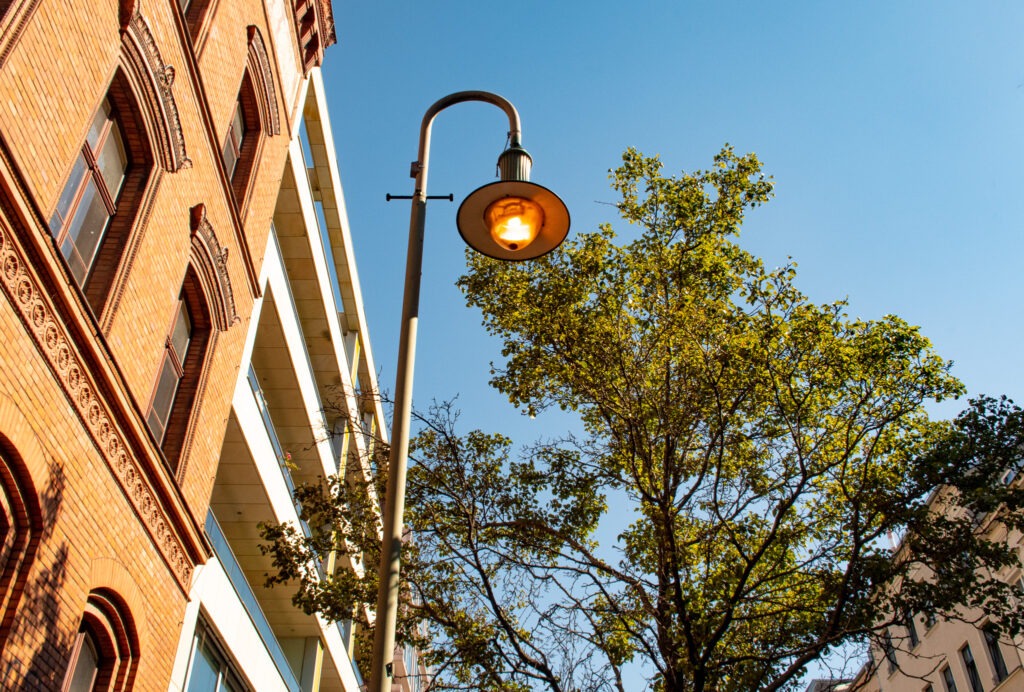
The orange-hued street lamps that illuminated East Berlin’s streets were another distinct feature. These lamps served practical purposes and represented a visual characteristic of the East’s urban landscape.
In contrast, West Berlin adopted more conventional street lighting, showcasing its own distinct preferences in urban aesthetics. Today, those orange-hued street lights have all been replaced, with only a very few remaining. You’ll know it when you see them, as they are orange, and left on during the daytime. I was lucky enough to spot one on my second day in Berlin.
9. Metal Plates
Berlin boasts a diverse collection of manhole covers, some with captivating designs that have even sparked T-shirt businesses. Notably, there are unique covers that date back to communist times, produced by Volkseigene Betriebe (or Publicly Owned Enterprises) for East German streets.
These distinct designs, although slated for replacement due to modern standards, are currently well-stocked in storage, ensuring their presence for the time being.
10. Glienicke Bridge
Glienicke Bridge, often referred to as the “Bridge of Spies,” stands as a symbolic link to the tensions of the Cold War era. Spanning the Havel River and connecting Potsdam in East Germany with West Berlin, the bridge gained notoriety as the site of high-stakes exchanges of captured spies between the United States and the Soviet Union.
It became a stage for dramatic swaps, showcasing the delicate negotiations and espionage intrigue that characterized the era.
When it came time to restore the bridge, the opposing sides couldn’t reach a consensus to collaborate on repairs, so they undertook separate efforts. The paint application differed, leading to uneven fading. Presently, the bridge showcases two distinct shades of green meeting at its center, a testament to the lack of agreement between the parties.
11. Neighbourhoods
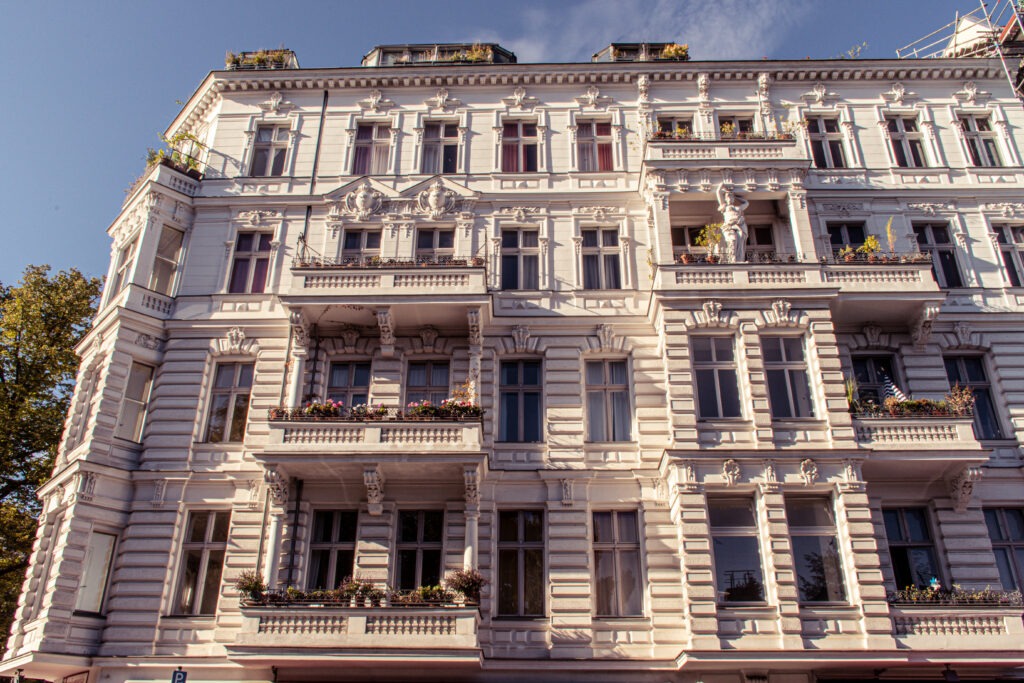
In East Berlin, neighbourhoods like Marzahn-Hellersdorf and Lichtenberg displayed Plattenbauten complexes, showcasing socialist architecture. Prenzlauer Berg and Friedrichshain offered glimpses of alternative culture.
In West Berlin, neighbourhoods like Charlottenburg displayed a mix of historical and modern architecture, while Kreuzberg embodied counterculture and alternative lifestyles.
Taking a walk through these neighbourhoods you’re bound to see how life in East Berlin was different.
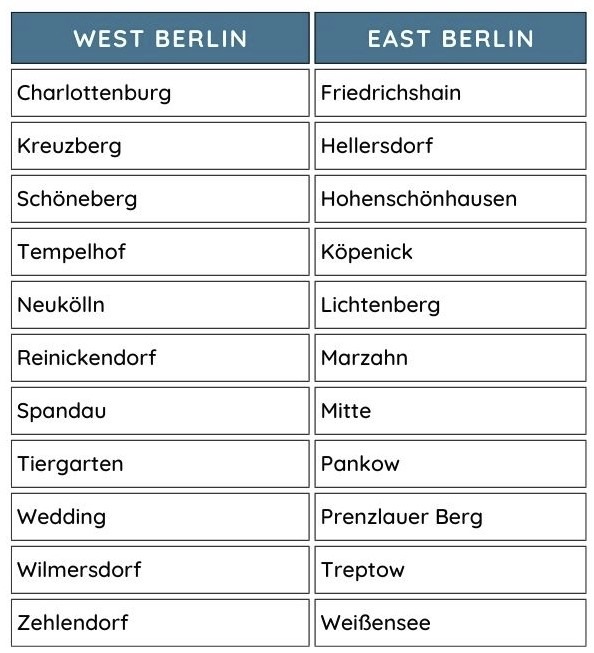
East Berlin vs West Berlin Famous Landmarks
East Berlin Landmarks You’re Going to Want to Visit
1. Karl-Marx-Allee
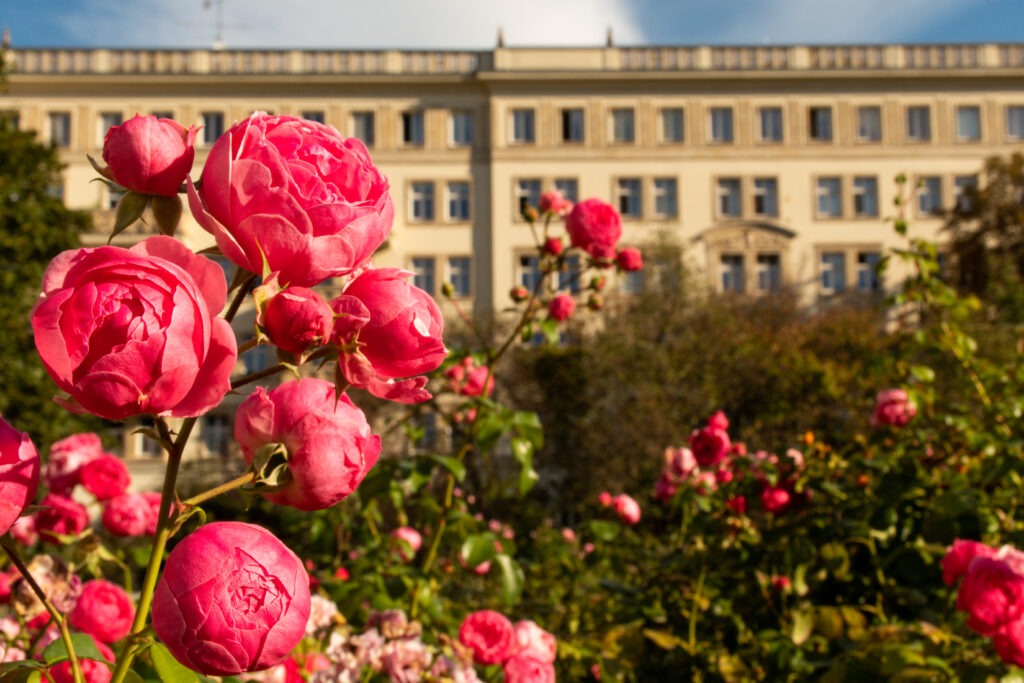
In the heart of East Berlin, Karl-Marx-Allee signifies the socialist triumph. The redesign in 1950 was intended to rival the Champs-Élysées in Paris.
From Alexanderplatz to Frankfurter Tor both sides of the street are lined with imposing facades of Plattenbauten, or pre-fabricated concrete buildings, rose as symbols of East Germany.
The above-average width of the boulevard was not only intended for urban traffic but was also to be used for marches and parades.
🌠Insider’s tip: Here are places to seek out along Karl Marx Allee:
- Cafe Sibylle (no. 72): a cafe that features artifacts and memorabilia from the Cold War communism-era
- Cafe Moskau (no. 34): is a striking venue with its sleek mid-century modern architecture with Soviet influences. Today it’s an event centre.
- Kino International (no. 33): has a distinctive, angular design and futuristic aesthetic. Back then it was a hub for East Berlin’s intellectual and creative elite, where spirited discussions about art and politics were had. Today it’s a movie theatre.
- Rose Garden (no. 103): a pretty rose garden full of white, pink and red roses stands between two Plattenbauten buildings. The Rose Garden was the location of the Uprising that took place on June 17, 1953. It was the first major crisis in the GDR, as workers took a stand against their own state.
2. Frankfurter Tor

Frankfurter Tor is a striking twin-towered gate that once stood as the eastern gateway to Karl-Marx-Allee. It served as a symbol of the Iron Curtain, marking the divide between East and West.
The design for the development comes from the architect Hermann Henselmann, who won a competition in 1953 and was responsible for redesigning the buildings along Karl-Marx-Allee.
3. Stasi Museum
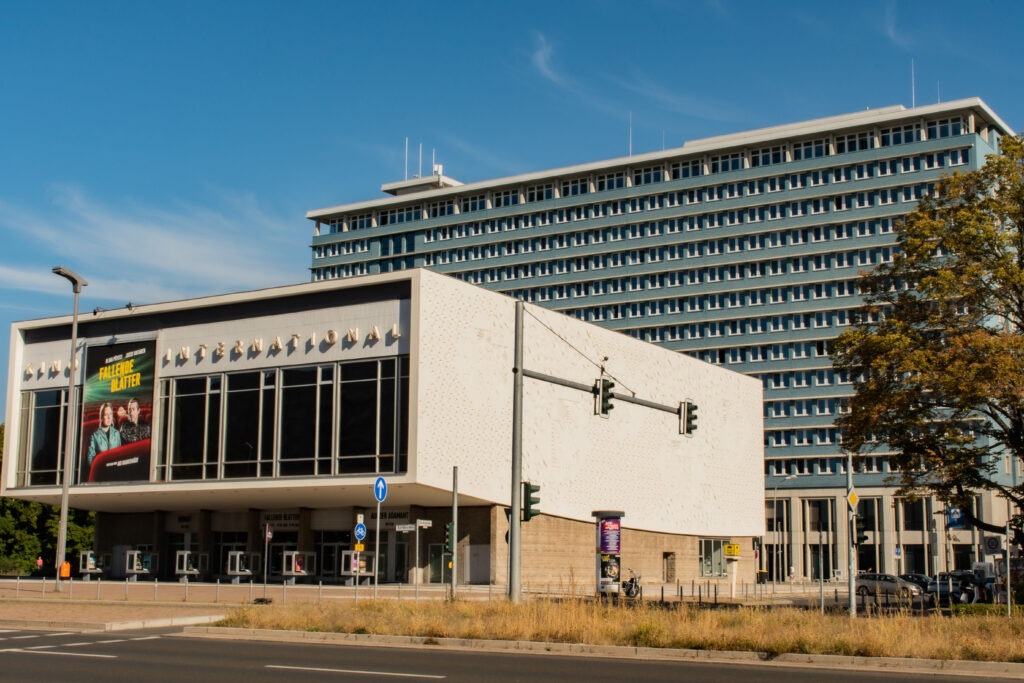
Housed in the former headquarters of the Ministry for State Security (Stasi), this museum offers you a glimpse into the surveillance state that once characterized East Germany.
Tour the offices, and you’ll be transported back in time to an era of clandestine espionage and the relentless pursuit of ideological conformity. The meticulously preserved artifacts, from spy cameras to secret files, provide a sobering glimpse into the extent of government control and surveillance that East Berliners endured.
One of the standout museums for me was this one, and I strongly recommend it. I used my Berlin Welcome Card to enjoy a discount during my visit.
📍Ruschestraße 103
4. Fernsehturm
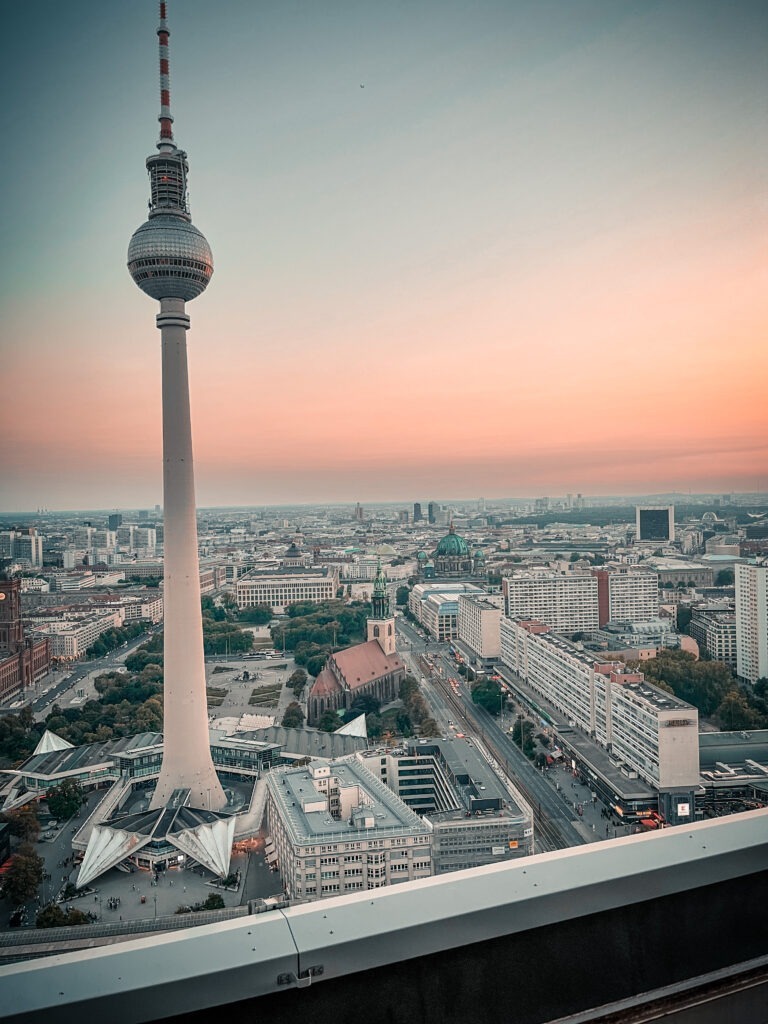
The Fernsehturm, or TV Tower, is a distinctive landmark towering over Alexanderplatz. Symbolizing East Germany’s engineering prowess, it offers panoramic views of the city and remains an enduring testament to technological achievement and urban identity.
📍Panoramastrasse 1A
Brandenburger Gate: A Landmark Shared by East and West Germany
The neoclassical Gate stood between East and West Germany, becoming part of the Berlin Wall. Now it stands as an iconic symbol of Berlin and German unity and is considered one of the best places to visit.
📍Pariser Platz on Unter den Linden boulevard
West Berlin Landmarks to Check Out
1. Kurfustendamm
Kurfustendamm or Ku’Damm for short is a long bustling boulevard that represents all the glitz and glamour of West Germany. Lined with high-end boutiques and restaurants it was in stark contrast to life in East Berlin.
I remember being in awe when I first saw it as a teenager in the late 80’s. Walking down the Ku’Damm today feels like the Eighties never left.
2. Kadewe
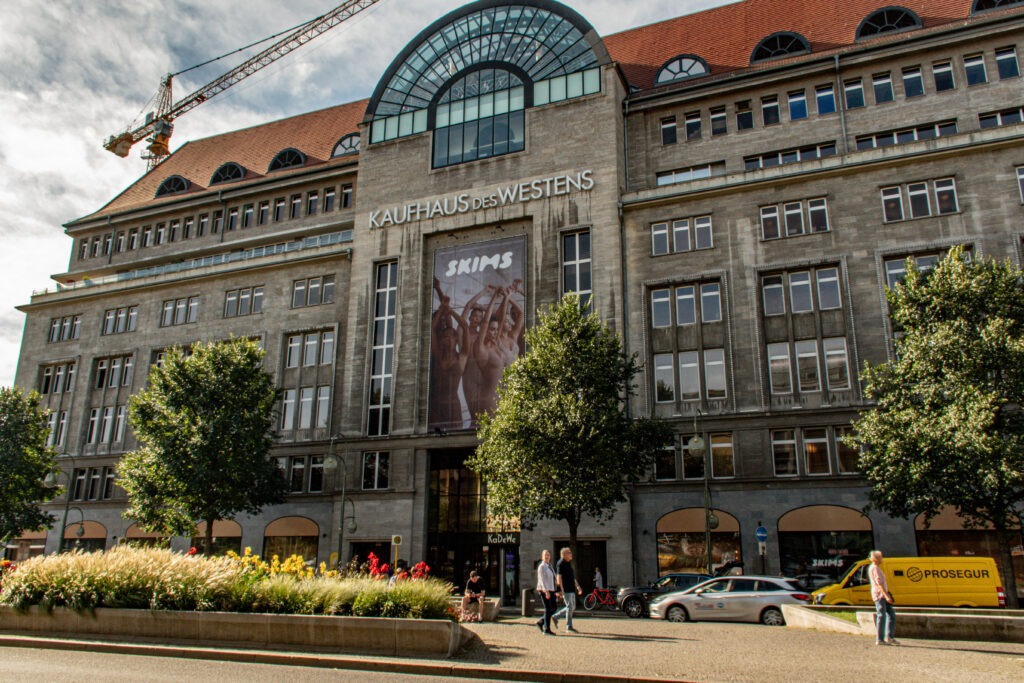
Kadewe, short for Kaufhaus des Westens, is a famous luxury department store in West Berlin. Renowned for its upscale shopping experience and diverse offerings, it has become an emblem of the city’s commercial and cosmopolitan style.
🌠Insider’s tip: Foodies take note! Head to the top floor for an endless array of the best consumables! They also make great Berlin souvenirs too.
📍Tauentzienstrasse 21-24
3. Savignyplatz
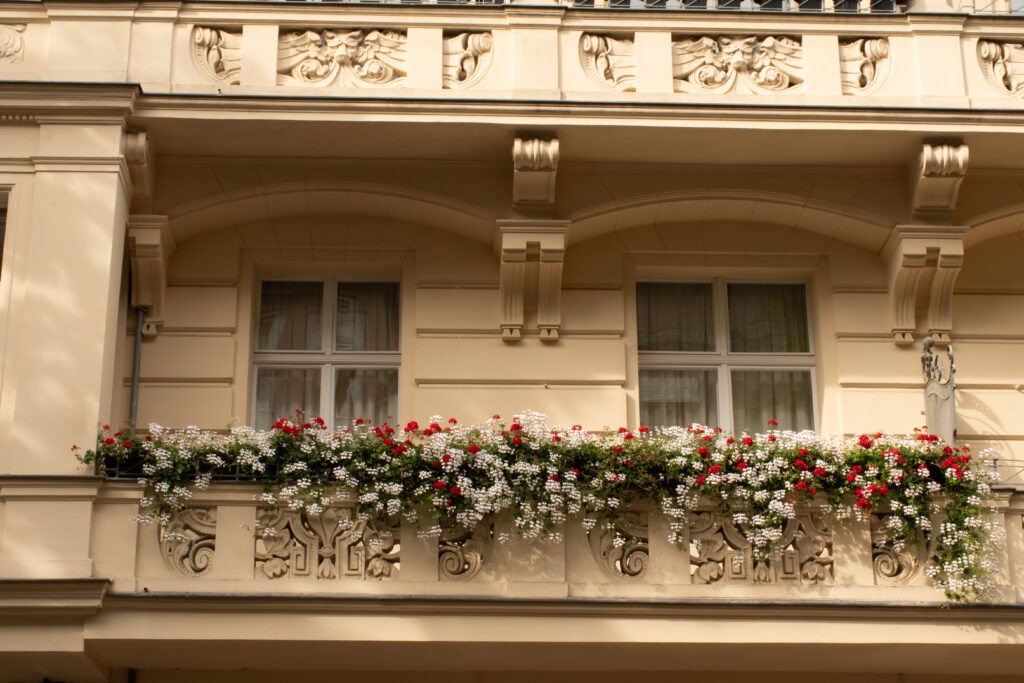
Just off of Ku’Damm take a stroll around Savignyplatz. It’s the perfect combination of park, cobbled streets, cafes and bookshops. Bookshops in West Berlin popped up everywhere, as a way to prove their literary freedoms compared to in the East.
Still to this day, the streets are chock-blocked with bookstores. When other cities are struggling to keep them alive, this area of Berlin is flourishing.
🌠Insider’s tip: Booklovers take note! Here are a couple of my favourites in the area. Marga Schoeller Bücherstube GmbH and Bücherbogen am Savignyplatz GmbH
4. Gedächtniskirche
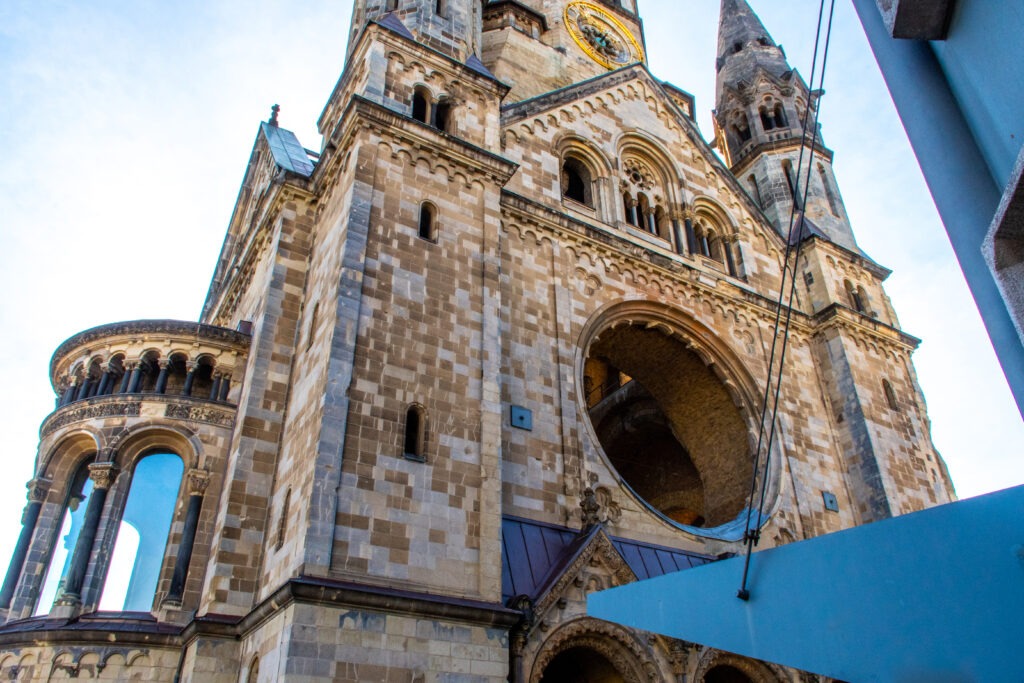
The Gedächtniskirche, or Kaiser Wilhelm Memorial Church, stands as a poignant memorial to World War II’s destruction. Its partially preserved spire and adjoining modern church serve as a reminder of both the city’s resilience and the scars of history.
🌠Insider’s tip: You can visit the inside of the church, now a museum (free, donations accepted)
📍Breitscheidplatz
As a Holidaymaker
The distinctions between West and East Berlin are just one of the reasons why this is such a unique city that needs to be seen.
The present-day East or West Berlin is a harmonious blend of both its historical legacies and a shared vision of the future that continues to shape the city’s dynamic essence.
Next, you might be interested in reading:
- easy day trips from Berlin by train
- what to see and do in Berlin’s Tiergarten Park
- see Berlin’s architecture from the Spree on this boat tour
